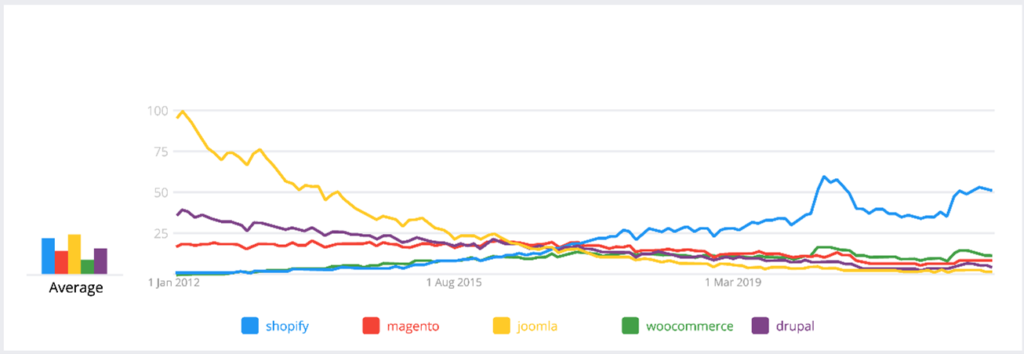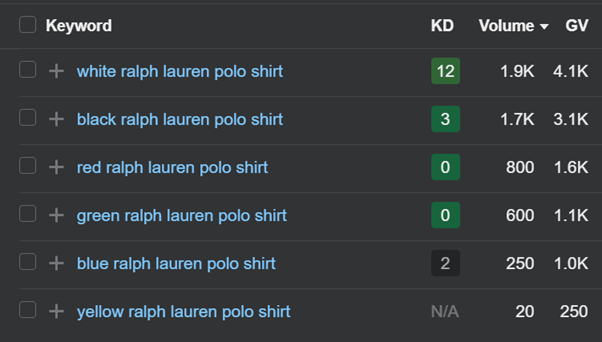
30-second abstract:
- Lowering reliance on canonical tags can reinforce product URL discovery on Shopify
- The way you construction your merchandise on Shopify can resolve how neatly those pages carry out
- Transferring reliance from canonical tags to wealthy inside anchor textual content is helping construct relevancy
Can anything else forestall the relentless upward thrust of Shopify? Again in 2012, the panorama was once ruled by way of WordPress, Magento, and Joomla. Speedy-forward 10 years and lots of within the trade now see Shopify because the main ecommerce platform, with the others going from leaders to laggards.

There are naturally a couple of causes for Shopify’s upward thrust to prominence, however arguably one of the crucial largest elements is that the platform is a lot more technically out there than different ecommerce infrastructure suppliers. Getting your head round a recent Magento set up or figuring out how Joomla works (which continues to be a thriller to me until date!) regularly calls for a undeniable stage of technical expertise. And, should you don’t possess it, then you want to spend additional assets outsourcing that paintings to somebody who does.
Shopify understood that baking simplicity and an “it simply works” ethos into their platform would permit on a regular basis marketers to get their websites up and operating temporarily, without having some extent in pc science or an enormous finances to handle their on-line presence. Alternatively, as user-friendly, because it may well be, there are nonetheless a couple of technical and search engine optimization hurdles to conquer if you need your Shopify website online to prevail at the SERPs.
On this article, I’ll take a better take a look at a key “out of the field” search engine optimization factor that regularly limits the relevance of product pages inside of Shopify and creates important website online bloat. Extra importantly, I’ll additionally percentage 4 attainable answers that can be utilized to mend the issue and maximize your product web page attainable. Let’s dive in.
The price of inefficiency
One thing that we regularly consult with our shoppers is making sure that Google can move slowly their internet sites as successfully as imaginable. We give an explanation for this by way of breaking down the fee to Google of crawling the internet. Each and every time Google visits a webpage at the Web there’s a bodily value to Google: the cost of electrical energy intake, water intake, {hardware}, tool, and the entire different belongings had to talk over with that web page. Whilst this value may well be 1000th of a penny consistent with URL, with the sheer quantity of URLs crawled by way of Google on a daily basis, the whole value is most likely staggering.
Due to this fact, in case you are serving Google webpages which are duplicated or now not related, you might be losing assets. Google has made some extent of pointing out that of their article on managing move slowly finances:
“With out steerage from you, Googlebot will attempt to move slowly all or many of the URLs that it is aware of about for your website online. If many of those URLs are duplicates, otherwise you don’t need them crawled for any other reason why (got rid of, unimportant, and so forth), this wastes numerous Google crawling time for your website online. That is the issue that you’ll definitely keep an eye on essentially the most.”
The important thing message this is that you’ll keep an eye on how a lot of Google’s move slowly time is wasted. Via aiming to scale back this waste, you might be making sure that the time Google spends for your web site is as productive as imaginable. This implies Google will spend extra time crawling URLs that experience true price, choosing up adjustments to current URLs, and finding new pages a lot quicker.
Use canonicals as a brief answer and now not the overall repair
A canonical tag is used when there are a couple of reproduction pages, permitting you to outline which of the duplicates must be deemed the right kind web page for Google to index.
Whilst they’re efficient within the brief time period, the life of a canonical tag highlights that there are structural problems inside of a web site, and it will have an effect on move slowly potency. Even supposing the canonical tag will point out to Google that you’ve decided on a most well-liked URL to index, the hunt engine nonetheless must move slowly all duplicates that comprise the canonical tag to come back to the consensus that you’ve set.
Slightly than the usage of a canonical tag as an enduring answer, it’s vital to take steps to mend the underlying structural drawback, subsequently negating using a canonical tag. This in flip can have a good have an effect on on move slowly potency.
What does this must do with Shopify product pages?
Put merely, product URLs on Shopify depend on canonical tags to be came upon. Let’s take a look at the 2 major reasons of this.
Merchandise in a couple of collections
The URL under is a product web page from a Shopify web site.
You are going to understand that the URL has the gathering the product is in is noticed within the URL as neatly. If this product is in a couple of collections, Shopify creates a couple of product URLs. As those are duplicates, Shopify handles this by way of the usage of canonical tags. Those canonical tags level to the most popular product URL, which doesn’t comprise a set:
The product highlighted above is lately in 4 collections, which means there at the moment are 5 various product URLs for Google to move slowly to seek out this one product that it must index. There may be, then again, every other factor that additional will increase this quantity: product variants.
Product variants
A product variant is a product characteristic that may enforce inside of Shopify. This might be colour, dimension, weight, or some other form of characteristic {that a} product will have. Growing variants of a product inside of Shopify lets in a consumer to make a choice attributes at the product web page. This can also be noticed under on our instance product URL as “dimension”:

On this setup, Shopify provides a parameter to the product URL referred to as ?variant. This comprises an ID that references the chosen variant. The URL under is our instance product URL with the medium variant decided on:
That is after all every other reproduction, which is treated by way of a canonical tag. If we start to calculate the whole selection of URLs this unmarried product has that depend on canonical tags, you are going to understand how it will have a unfavourable have an effect on on move slowly potency.
In response to this product being in 4 collections and having 4 variants, there are a complete of 20 product URLs that depend on a canonical tag. This implies Google must steadily move slowly 21 product URLs to find the one product URL that wishes indexing.
10,000 URLs crawled to index 600
Whilst you issue within the sheer selection of merchandise throughout a whole web site, it’s clean to peer how this determine can upload up. If our instance web site has 600 merchandise, and every product seems in 4 collections with 4 variants every, then Google will wish to steadily move slowly in way over 10,000 product URLs to seek out the 600 which have been asked to be listed.
How do you repair this on Shopify?
There are two distinct issues we wish to repair right here: the problem with merchandise showing in a couple of collections, and the problem with product variants. There are answers for each — then again, enforcing them would require compromise in sure spaces.
Merchandise in a couple of collections: The repair
This repair works by way of getting rid of hyperlinks to product URLs with the gathering identify within the product URL. The primary perpetrator this is the gathering URL — in particular the theme document that powers assortment URLs. On Shopify, this document is named product-grid-item.liquid.
You’ll be able to navigate to this document by way of the next path inside of your Shopify admin.
On-line Retailer > Topics > Customise > Theme Movements > Edit Code > Snippets
Inside this document there are HTML links that reference product URLs containing the gathering identify:

The “inside of: assortment” detail is what’s liable for pulling the gathering identify into the product URL. Putting off this guarantees that the gathering identify not seems within the product URL.
Alternatively, ahead of you bounce in, there are some things you’ll want to remember:
- It’s endorsed that you just seek advice from your internet building crew ahead of making this variation.
- Apps that you just use would possibly want the “inside of: assortment” capability, so it’s value checking with app toughen on whether or not or now not this can also be modified.
- This alteration affects the breadcrumb on product URLs. If that is problematic, then I’d recommend development breadcrumbs manually the usage of META fields with a devoted META fields app.
- You are going to additionally wish to make certain that handbook hyperlinks that use this layout are modified.
- There could also be different template information that comprise “inside of: assortment” so it’s value liaising along with your building crew to spot those.
Product variants: The repair (or is it?)
Sadly, the option to product variants is extra complicated and in the long run is dependent upon how a lot search engine optimization price you might be getting out of your current product variants. The advice this is to first learn how viable product variant key phrases are with regards to seek quantity and marketplace alternative.
As an example, if our imaginary Shopify retailer sells Ralph Lauren polo shirts, then my variants usually are colour and dimension. Via operating a handy guide a rough seek for the product sort plus those variants, we will see that there’s seek quantity and subsequently it’s going to be vital that my variants are indexable and optimized.

Repair Possibility #1: Optimize ?variant URLs
This primary possibility is viable should you consider that there’s seek quantity alternative throughout a variety of your product variants. The idea of this repair is to construct good judgment into your theme code, in order that when a variant is chosen, the variant identify is appended into the web page identify tag and the place imaginable, the product description.
This alteration will most likely rely on your theme setup and, as with all alternate, it’s endorsed that you just seek advice from your internet building crew. Extra main points on how to try this can also be discovered by way of the Shopify neighborhood thread under:
Any other factor to remember with this answer is that you are going to wish to take away the canonical tag this is lately in position on ?variant URLs. The primary problem to this manner is which you can wish to enforce it sitewide throughout all product variants — however now not all variants will essentially have to be had seek quantity.
Repair Possibility #2: Optimize major product URL for variants
If you need extra keep an eye on over which product units have optimized variants, then this selection may well be for you. Via optimizing the principle product URL for variants, by way of together with variant key phrases within the product description and META knowledge, you are going to stand an opportunity of being visual for those product variant key phrases.
The disadvantage this is that product URLs may grow to be over-optimized and now not as related as a devoted, optimized product variant URL.
Repair Possibility #3: Disallow ?variant parameter
If it seems that your product variants have minimum or no seek price then disallowing the ?variant parameter on your robots.txt document may well be the most suitable choice. This may occasionally forestall Google crawling ?variant URLs, subsequently making move slowly job extra environment friendly.
Repair Possibility #4: Person merchandise consistent with variant
In case your product variants do have seek viability, then growing person merchandise consistent with variant may well be an efficient possibility. That is one thing we’ve got noticed outlets like Health club Shark do with colour. The product under is available in quite a lot of various colours, every of which has its personal product URL and does now not depend on variants, e.g.:
https://www.gymshark.com/merchandise/gymshark-element-baselayer-t-shirt-black-aw21

With extra keep an eye on over each META knowledge and optimized content material, this manner approach it’s more straightforward to construct deeper relevance for product variants. The disadvantage this is that there are merely extra merchandise to control throughout the CMS.
Shopify & search engine optimization problems: Ultimate ideas
As I discussed previous, one of the crucial causes for Shopify’s meteoric upward thrust has been the “it simply works” ethos that makes the platform one of these cinch to make use of. However that’s to not say that the platform doesn’t be afflicted by a couple of search engine optimization snags.
Along with the canonical factor, Google’s Core Internet Vitals can also be every other supply of complications for SEOs who paintings with the platform. However there are usually workarounds for many who are keen to make the effort to enforce them. You’ll be able to be told extra about tips on how to navigate those in our final information to Shopify search engine optimization (2022).
There also are hopeful indicators that the Shopify crew are an increasing number of receptive to the wishes of the search engine optimization neighborhood. The crew have steadily taken on board comments from SEOs to reinforce their product, from permitting customers to edit the robots.txt document, to bearing in mind sub-folder global constructions. So, we will hope that easy-to-implement answers round using canonicals and different problems will probably be rolled out ahead of too lengthy.
Can anything else forestall the relentless upward thrust of Shopify? Again in 2012, the panorama was once ruled by way of WordPress, Magento and Joomla. Speedy-forward 10 years, and lots of within the trade now see Shopify because the main e-commerce platform, with the others going from leaders to laggards.
There are naturally a couple of causes for Shopify’s upward thrust to prominence, however arguably one of the crucial largest elements is that the platform is a lot more technically out there than different ecommerce infrastructure suppliers. Getting your head round a recent Magento set up or figuring out how Joomla works (which continues to be a thriller to me to at the present time!) regularly calls for a undeniable stage of technical knowhow. And, should you don’t possess it, then you want to spend additional assets outsourcing that paintings to somebody who does.
Shopify understood that baking in simplicity and an “it simply works” ethos into their platform would permit on a regular basis marketers to get their websites up and operating temporarily, without having some extent in pc science or an enormous finances to handle their on-line presence. Alternatively, as user-friendly because it may well be, there are nonetheless a couple of technical and search engine optimization hurdles to conquer if you need your Shopify website online to prevail at the SERPs.
On this article, I’ll take a better take a look at a key “out of the field” search engine optimization factor that regularly limits the relevance of product pages inside of Shopify and creates important website online bloat. Extra importantly, I’ll additionally percentage 4 attainable answers that can be utilized to mend the issue and maximize your product web page attainable. Let’s dive in.
The price of inefficiency
One thing that we regularly consult with our shoppers is making sure that Google can move slowly their internet sites as successfully as imaginable. We give an explanation for this by way of breaking down the fee to Google of crawling the internet. Each and every time Google visits a webpage at the Web there’s a bodily value to Google: the cost of electrical energy intake, water intake, {hardware}, tool, and the entire different belongings had to talk over with that web page. Whilst this value may well be 1000th of a penny consistent with URL, with the sheer quantity of URLs crawled by way of Google on a daily basis, the whole value is most likely staggering.
Due to this fact, in case you are serving Google webpages which are duplicated or now not related, you might be losing assets. Google have made some extent of pointing out that of their article on managing move slowly finances:
“With out steerage from you, Googlebot will attempt to move slowly all or many of the URLs that it is aware of about for your website online. If many of those URLs are duplicates, otherwise you don’t need them crawled for any other reason why (got rid of, unimportant, and so forth), this wastes numerous Google crawling time for your website online. That is the issue that you’ll definitely keep an eye on essentially the most.”
The important thing message this is that you’ll keep an eye on how a lot of Google’s move slowly time is wasted. Via aiming to scale back this waste, you might be making sure that the time Google spends for your web site is as productive as imaginable. This implies Google will spend extra time crawling URLs that experience true price, choosing up adjustments to current URLs and finding new pages a lot quicker.
The use of canonicals as a brief answer and now not the overall repair
A canonical tag is used when there are a couple of reproduction pages, permitting you to outline which of the duplicates must be deemed the right kind web page for Google to index.
Whilst they’re efficient within the brief time period, the life of a canonical tag highlights that there are structural problems inside of a web site, and it will have an effect on move slowly potency. Even supposing the canonical tag will point out to Google that you’ve decided on a most well-liked URL to index, the hunt engine nonetheless must move slowly all duplicates that comprise the canonical tag to come back to the consensus that you’ve set.
So, fairly than the usage of a canonical tag as an enduring answer, it’s vital to take steps to mend the underlying structural drawback, and subsequently negating using the canonical tag. This in flip can have a good have an effect on on move slowly potency.
What does this must do with Shopify product pages?
Put merely, product URLs on Shopify depend on canonical tags to be came upon. Let’s take a look at the 2 major reasons of this.
Merchandise in a couple of collections
The URL under is a product web page from a Shopify web site.
You are going to understand that the URL has the gathering the product is in inside of it. If this product is in a couple of collections, Shopify creates a couple of product URLs. As those are duplicates, Shopify handles this by way of the usage of canonical tags. Those canonical tags level to the most popular product URL, which doesn’t comprise a set:
The product highlighted above is lately in 4 collections, which means there at the moment are 5 various product URLs for Google to move slowly to seek out this one product that it must index. There may be, then again, every other factor that additional will increase this quantity: product variants.
Product variants
A product variant is a product characteristic that may enforce inside of Shopify. This might be colour, dimension, weight or some other form of characteristic {that a} product will have. Via growing variants of a product inside of Shopify, it lets in a consumer to make a choice attributes at the product web page. This can also be noticed under on our instance product URL as “dimension”:

On this setup, Shopify provides a parameter to the product URL referred to as ?variant. This comprises an ID that references the chosen variant. The URL under is our instance product URL with the medium variant decided on:
That is after all every other reproduction, which is treated by way of a canonical tag. If we start to calculate the whole selection of URLs this unmarried product has that depend on canonical tags, you are going to start see how it will have a unfavourable have an effect on on move slowly potency.
In response to this product being in 4 collections and having 4 variants, there are a complete of 20 product URLs that depend on a canonical tag. This implies Google must steadily move slowly 21 product URLs to find the one product URL that wishes indexing.
10,000 URLs crawled to index 600
Whilst you issue within the sheer selection of merchandise throughout a whole web site, it’s clean to peer how this determine can upload up. If our instance web site has 600 merchandise, and every product seems in 4 collections with 4 variants every, then Google will wish to steadily move slowly in way over 10,000 product URLs to seek out the 600 which have been asked to be listed.
How do you repair this on Shopify?
There are two distinct issues we wish to repair right here: the problem with merchandise showing in a couple of collections, and the problem with product variants. There are answers for each — then again, enforcing them would require compromise in sure spaces.
Merchandise in a couple of collections: The repair
This repair works by way of getting rid of hyperlinks to product URLs with the gathering identify within the product URL. The primary perpetrator this is the gathering URL — in particular the theme document that powers assortment URLs. On Shopify, this document is named product-grid-item.liquid.
You’ll be able to navigate to this document by way of the next path inside of your Shopify admin.
On-line Retailer > Topics > Customise > Theme Movements > Edit Code > Snippets
Inside this document there are HTML links that reference product URLs containing the gathering identify:

The “inside of: assortment” detail is what’s liable for pulling the gathering identify into the product URL. Putting off this guarantees that the gathering identify not seems within the product URL.
Alternatively, ahead of you bounce in, there are some things you’ll want to remember:
- It’s endorsed that you just seek advice from your internet building crew ahead of making this variation.
- Apps that you just use would possibly want the “inside of: assortment” capability, so it’s value checking with app toughen on whether or not or now not this can also be modified.
- This alteration affects the breadcrumb on product URLs. If that is problematic, then I’d recommend development breadcrumbs manually the usage of META fields with a devoted META fields app.
- You are going to additionally wish to make certain that handbook hyperlinks that use this layout are modified.
- There could also be different template information that comprise “inside of: assortment” so it’s value liaising along with your building crew to spot those.
Product variants: The repair (or is it?)
Sadly, the option to product variants is extra complicated and in the long run is dependent upon how a lot search engine optimization price you might be getting out of your current product variants. The advice this is to first learn how viable product variant key phrases are with regards to seek quantity and marketplace alternative.
As an example, if our imaginary Shopify retailer sells Ralph Lauren polo shirts, then my variants usually are colour and dimension. Via operating a handy guide a rough seek for the product sort plus those variants, we will see that there’s seek quantity and subsequently it’s going to be vital that my variants are indexable and optimized.

Repair Possibility #1: Optimize ?variant URLs
This primary possibility is viable should you consider that there’s seek quantity alternative throughout a variety of your product variants. The idea of this repair is to construct good judgment into your theme code, in order that when a variant is chosen, the variant identify is appended into the web page identify tag and the place imaginable, the product description.
This alteration will most likely rely on your theme setup and, as with all alternate, it’s endorsed that you just seek advice from your internet building crew. Extra main points on how to try this can also be discovered by way of the Shopify neighborhood thread under:
Any other factor to remember with this answer is that you are going to wish to take away the canonical tag this is lately in position on ?variant URLs. The primary problem to this manner is which you can wish to enforce it sitewide throughout all product variants — however now not all variants will essentially have to be had seek quantity.
Repair Possibility #2: Optimize major product URL for variants
If you need extra keep an eye on over which product units have optimized variants, then this selection may well be for you. Via optimizing the principle product URL for variants, by way of together with variant key phrases within the product description and META knowledge, you are going to stand an opportunity of being visual for those product variant key phrases.
The disadvantage this is that product URLs may grow to be over-optimized and now not as related as a devoted, optimized product variant URL.
Repair Possibility #3: Disallow ?variant parameter
If it seems that your product variants have minimum or no seek price then disallowing the ?variant parameter on your robots.txt document may well be the most suitable choice. This may occasionally forestall Google crawling ?variant URLs, subsequently making move slowly job extra environment friendly.
Repair Possibility #4: Person merchandise consistent with variant
In case your product variants do have seek viability, then growing person merchandise consistent with variant may well be an efficient possibility. That is one thing we’ve got noticed outlets like Health club Shark do with colour. The product under is available in quite a lot of various colours, every of which has its personal product URL and does now not depend on variants, e.g.:
https://www.gymshark.com/merchandise/gymshark-element-baselayer-t-shirt-black-aw21

With extra keep an eye on over each META knowledge and optimized content material, this manner approach it’s more straightforward to construct deeper relevance for product variants. The disadvantage this is that there are merely extra merchandise to control throughout the CMS.
Shopify & search engine optimization problems: Ultimate ideas
As I discussed previous, one of the crucial causes for Shopify’s meteoric upward thrust has been the “it simply works” ethos that makes the platform one of these cinch to make use of. However that’s to not say that the platform doesn’t be afflicted by a couple of search engine optimization snags.
Along with the canonical factor, Google’s Core Internet Vitals can also be every other supply of complications for SEOs who paintings with the platform. However there are usually workarounds for many who are keen to make the effort to enforce them. You’ll be able to be told extra about tips on how to navigate those in our final information to Shopify search engine optimization (2022).
There also are hopeful indicators that the Shopify crew are an increasing number of receptive to the wishes of the search engine optimization neighborhood. The crew have steadily taken on board comments from SEOs to reinforce their product, from permitting customers to edit the robots.txt document, to bearing in mind sub-folder global constructions. So, we will hope that easy-to-implement answers round using canonicals and different problems will probably be rolled out ahead of too lengthy.
Marc Swann is Director of Seek at Glass Virtual, a virtual advertising company providing search engine optimization, internet online affiliate marketing, and paid seek products and services. Marc has been operating in virtual advertising for 12 years and focuses on technical search engine optimization. At Glass Virtual, his center of attention is at the natural seek provider, making sure our groups are handing over most price for his or her shoppers.
Subscribe to the Seek Engine Watch publication for insights on search engine optimization, the hunt panorama, seek advertising, virtual advertising, management, podcasts, and extra.
Sign up for the dialog with us on LinkedIn and Twitter.






















